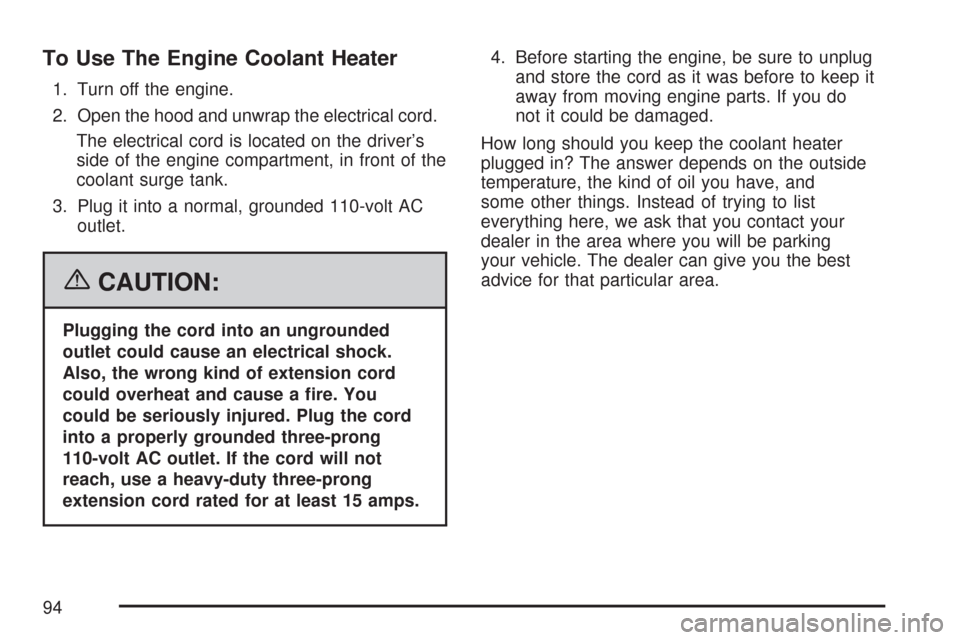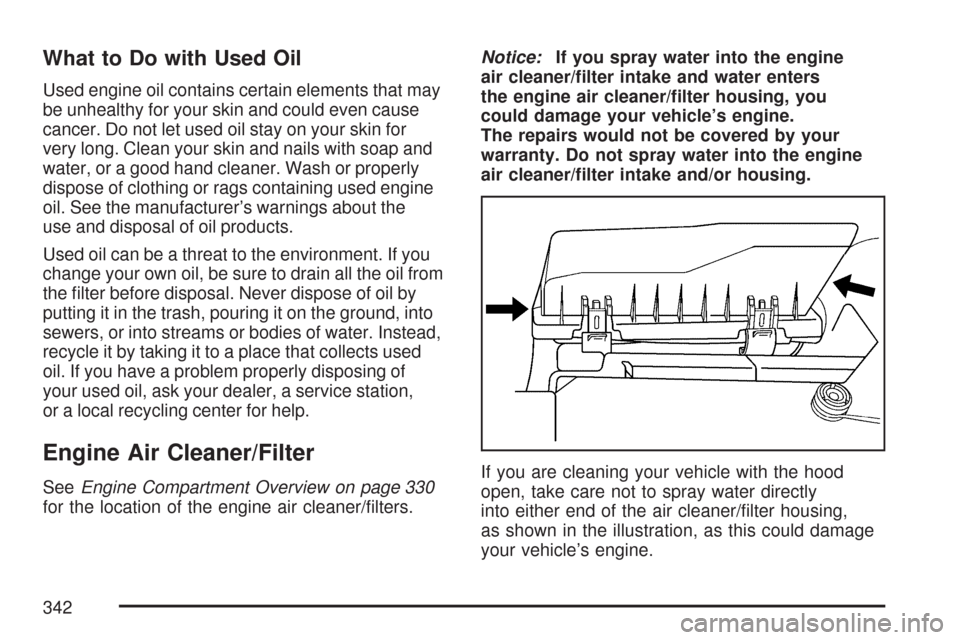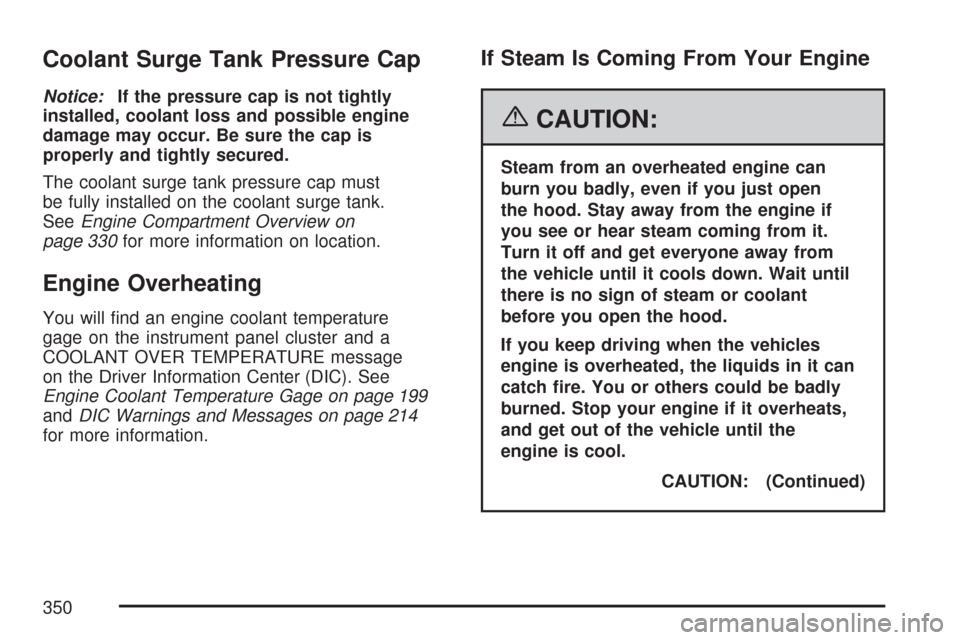Page 94 of 488

To Use The Engine Coolant Heater
1. Turn off the engine.
2. Open the hood and unwrap the electrical cord.
The electrical cord is located on the driver’s
side of the engine compartment, in front of the
coolant surge tank.
3. Plug it into a normal, grounded 110-volt AC
outlet.
{CAUTION:
Plugging the cord into an ungrounded
outlet could cause an electrical shock.
Also, the wrong kind of extension cord
could overheat and cause a �re. You
could be seriously injured. Plug the cord
into a properly grounded three-prong
110-volt AC outlet. If the cord will not
reach, use a heavy-duty three-prong
extension cord rated for at least 15 amps.4. Before starting the engine, be sure to unplug
and store the cord as it was before to keep it
away from moving engine parts. If you do
not it could be damaged.
How long should you keep the coolant heater
plugged in? The answer depends on the outside
temperature, the kind of oil you have, and
some other things. Instead of trying to list
everything here, we ask that you contact your
dealer in the area where you will be parking
your vehicle. The dealer can give you the best
advice for that particular area.
94
Page 173 of 488

Turn and hold the knob clockwise to brighten the
lights or counterclockwise to dim them. During
the day, this knob will adjust the instrument panel
brightness and at night will adjust all interior
lighting.
Be sure not to have this knob turned all the way
down with the lamps on during the day. Your
Driver Information Center (DIC) may not be visible.
Courtesy Lamps
When any door or the hatch/trunk lid is opened,
the interior lamps will go on unless it is bright
outside.
You can also turn the courtesy lamps on and off
by pressing the instrument panel brightness knob.
Entry/Exit Lighting
With entry lighting, the interior lamps will come on
when entering the vehicle. The interior lamps
will come on for about 20 seconds when the
engine is off.
You can turn exit and entry lighting off by quickly
turning the courtesy lamps on and off.
Reading Lamps
The inside rearview mirror includes two reading
lamps. The lamps will go on when a door is
opened. When the doors are closed, each lamp
can be turned on individually by pressing the
switch for that lamp.
An ambient light is located in the passenger sun
visor clip. This light stays on while driving to
keep the cabin from being too dark.
Battery Run-Down Protection
This vehicle has a feature to help prevent the
battery from being drained in case any of
the following lamps are left on; the underhood
lamp, if your vehicle has this feature, vanity mirror
lamps, cargo lamps, reading lamps, console or
glove box lamps. If any of these lamps are left on,
they will automatically time-out after about
10 minutes. To reset it, all of the above lamps
must be turned off or the ignition key on.
173
Page 322 of 488

If this occurs, use a gasoline rated at 87 octane or
higher as soon as possible. Otherwise, you might
damage your engine. If you are using gasoline
rated at 87 octane or higher and you hear heavy
knocking, your engine needs service.
If your vehicle has the 7.0L V8 engine
(VIN Code E), use premium unleaded gasoline
with a posted octane rating of 91 or higher.
For best performance, use premium unleaded
gasoline with a posted octane rating of 93.
In an emergency, you can use regular unleaded
gasoline with an octane rating of 87 or higher.
If 87 octane fuel is used, do not perform any
aggressive driving maneuvers such as wide open
throttle applications. You may also hear audible
spark knock during acceleration. Re�ll your
tank with premium fuel as soon as possible to
avoid damaging your engine. If you are using
gasoline rated at 91 octane or higher and you
hear heavy knocking, your engine needs service.Gasoline Speci�cations
At a minimum, gasoline should meet ASTM
speci�cation D 4814 in the United States or
CAN/CGSB-3.5 in Canada. Some gasolines may
contain an octane-enhancing additive called
methylcyclopentadienyl manganese tricarbonyl
(MMT). General Motors recommends against the
use of gasolines containing MMT. SeeAdditives
on page 323for additional information.
California Fuel
If your vehicle is certi�ed to meet California
Emissions Standards, it is designed to operate on
fuels that meet California speci�cations. See the
underhood emission control label. If this fuel is not
available in states adopting California emissions
standards, your vehicle will operate satisfactorily
on fuels meeting federal speci�cations, but
emission control system performance may be
affected. The malfunction indicator lamp may turn
on and your vehicle may fail a smog-check test.
SeeMalfunction Indicator Lamp on page 200.
322
Page 329 of 488
Hood Release
To open the hood, do the following:
1. Pull the hood
release lever with
this symbol on
it. It is located
inside the vehicle
below the instrument
panel on the
driver’s side.
2. Go to the side of the vehicle and pull up on
the rear edge of the hood, near the windshield.
Before closing the hood, be sure all the �ller caps
are on properly. Then, just pull the hood down
and close it �rmly.
329
Page 330 of 488
Engine Compartment Overview
If your vehicle has the 6.0L LS2 V8 engine and you are facing the front, when you open the hood,
here is what you will see:
330
Page 332 of 488
If your vehicle has the 7.0L LS7 V8 engine and you are facing the driver’s side of the vehicle, when you
open the hood, here is what you will see:
332
Page 342 of 488

What to Do with Used Oil
Used engine oil contains certain elements that may
be unhealthy for your skin and could even cause
cancer. Do not let used oil stay on your skin for
very long. Clean your skin and nails with soap and
water, or a good hand cleaner. Wash or properly
dispose of clothing or rags containing used engine
oil. See the manufacturer’s warnings about the
use and disposal of oil products.
Used oil can be a threat to the environment. If you
change your own oil, be sure to drain all the oil from
the �lter before disposal. Never dispose of oil by
putting it in the trash, pouring it on the ground, into
sewers, or into streams or bodies of water. Instead,
recycle it by taking it to a place that collects used
oil. If you have a problem properly disposing of
your used oil, ask your dealer, a service station,
or a local recycling center for help.
Engine Air Cleaner/Filter
SeeEngine Compartment Overview on page 330
for the location of the engine air cleaner/�lters.Notice:If you spray water into the engine
air cleaner/�lter intake and water enters
the engine air cleaner/�lter housing, you
could damage your vehicle’s engine.
The repairs would not be covered by your
warranty. Do not spray water into the engine
air cleaner/�lter intake and/or housing.
If you are cleaning your vehicle with the hood
open, take care not to spray water directly
into either end of the air cleaner/�lter housing,
as shown in the illustration, as this could damage
your vehicle’s engine.
342
Page 350 of 488

Coolant Surge Tank Pressure Cap
Notice:If the pressure cap is not tightly
installed, coolant loss and possible engine
damage may occur. Be sure the cap is
properly and tightly secured.
The coolant surge tank pressure cap must
be fully installed on the coolant surge tank.
SeeEngine Compartment Overview on
page 330for more information on location.
Engine Overheating
You will �nd an engine coolant temperature
gage on the instrument panel cluster and a
COOLANT OVER TEMPERATURE message
on the Driver Information Center (DIC). See
Engine Coolant Temperature Gage on page 199
andDIC Warnings and Messages on page 214
for more information.
If Steam Is Coming From Your Engine
{CAUTION:
Steam from an overheated engine can
burn you badly, even if you just open
the hood. Stay away from the engine if
you see or hear steam coming from it.
Turn it off and get everyone away from
the vehicle until it cools down. Wait until
there is no sign of steam or coolant
before you open the hood.
If you keep driving when the vehicles
engine is overheated, the liquids in it can
catch �re. You or others could be badly
burned. Stop your engine if it overheats,
and get out of the vehicle until the
engine is cool.
CAUTION: (Continued)
350